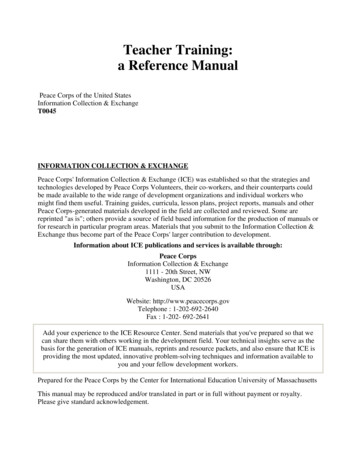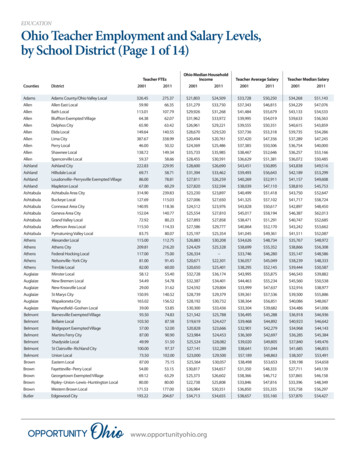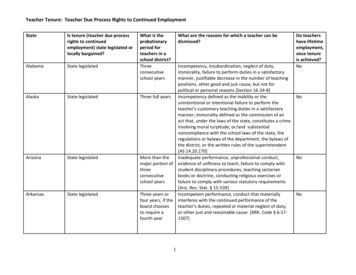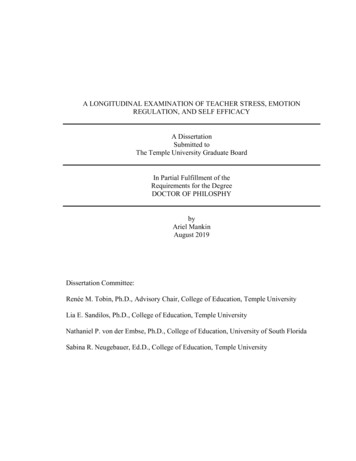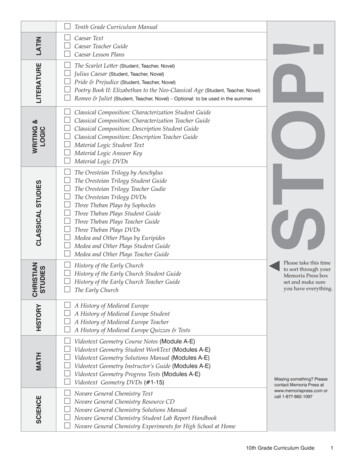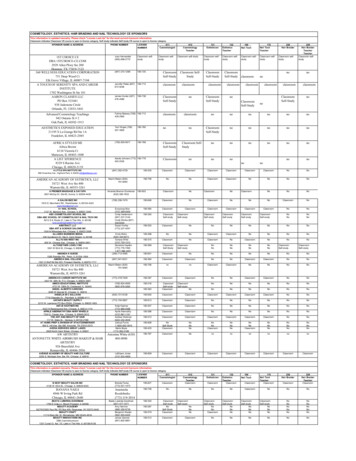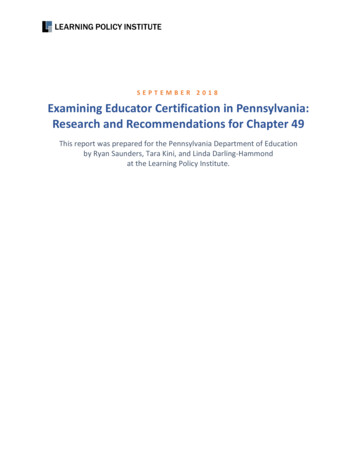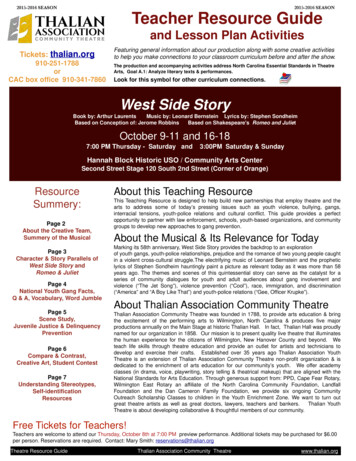
Transcription
2015-2016 SEASON2015-2016 SEASONTeacher Resource Guide !and Lesson Plan ActivitiesTickets: thalian.org!910-251-1788 !or!CAC box office 910-341-7860!!!The production and accompanying activitiesaddress North Carolina Essential Standards in TheatreArts, Goal A.1: Analyze literary texts & performances. !Look for this symbol for other curriculum connections.West Side Story!!October 9-11! and 16-18!! 7:00 PM Thursday - Saturday and 3:00PM Saturday & Sunday!!!Hannah Block Historic USO/ Community Arts Center!!Second Street Stage 120 South 2nd Street (Corner of Orange)!Book by: Arthur LaurentsMusic by: Leonard Bernstein Lyrics by: Stephen Sondheim !Based on Conception of: Jerome RobbinsBased on Shakespeare's Romeo and Juliet!!!Featuring general information about our production along with some creative activitiesto help you make connections to your classroom curriculum before and after the show. !Resource!Summery:!!!Page 2!About the Creative Team,Summery of the Musical!!Page 3!Character & Story Parallels ofWest Side Story andRomeo & Juliet !!Page 4!National Youth Gang Facts,Q & A, Vocabulary, Word Jumble !!Page 5!Scene Study,Juvenile Justice & DelinquencyPrevention !!!Page 6!Compare & Contrast,Creative Art, Student Contest!!Page 7!Understanding Stereotypes,Self-identification!ResourcesAbout this Teaching Resource!This Teaching Resource is designed to help build new partnerships that employ theatre and thearts to address some of today’s pressing issues such as youth violence, bullying, gangs,interracial tensions, youth-police relations and cultural conflict. This guide provides a perfectopportunity to partner with law enforcement, schools, youth-based organizations, and communitygroups to develop new approaches to gang prevention.!!About the Musical & Its Relevance for Today!Marking its 58th anniversary, West Side Story provides the backdrop to an exploration!of youth gangs, youth-police relationships, prejudice and the romance of two young people caughtin a violent cross-cultural struggle.The electrifying music of Leonard Bernstein and the propheticlyrics of Stephen Sondheim hauntingly paint a picture as relevant today as it was more than 58years ago. The themes and scenes of this quintessential story can serve as the catalyst for aseries of community dialogues for youth and adult audiences about gang involvement andviolence (“The Jet Song”), violence prevention (“Cool”), race, immigration, and discrimination(“America” and “A Boy Like That”) and youth-police relations (“Gee, Officer Krupke”).!!About Thalian Association Community TheatreThalian Association Community Theatre was founded in 1788, to provide arts education & bringthe excitement of the performing arts to Wilmington, North Carolina & produces five majorproductions annually on the Main Stage at historic Thalian Hall. In fact, Thalian Hall was proudlynamed for our organization in 1858. Our mission is to present quality live theatre that illuminatesthe human experience for the citizens of Wilmington, New Hanover County and beyond. Weteach life skills through theatre education and provide an outlet for artists and technicians todevelop and exercise their crafts. Established over 35 years ago Thalian Association YouthTheatre is an extension of Thalian Association Community Theatre non-profit organization & isdedicated to the enrichment of arts education for our community’s youth. We offer academyclasses (in drama, voice, playwriting, story telling & theatrical makeup) that are aligned with theNational Standards for Arts Education. Through generous support from: PPD, Cape Fear Rotary,Wilmington East Rotary an affiliate of the North Carolina Community Foundation, LandfallFoundation and the Dan Cameron Family Foundation, we provide six ongoing CommunityOutreach Scholarship Classes to children in the Youth Enrichment Zone. We want to turn outgreat theatre artists as well as great doctors, lawyers, teachers and bankers.Thalian YouthTheatre is about developing collaborative & thoughtful members of our community.Free Tickets for Teachers!!Teachers are welcome to attend our Thursday, October 8th at 7:00 PM preview performance. Additional tickets may be purchased for 6.00per person. Reservations are required. Contact: Mary Smith: reservations@thalian.orgTheatre Resource GuideThalian Association Community Theatrewww.thalian.org
!"There's a place for us, a time and place for us. Hold my hand & we're halfway there.Hold my hand & I'll take you there.Somehow, someday, somewhere!"Shakespeare's Romeo and Juliet, is transported to modern-day New York City, as two young idealisticlovers find themselves caught between warring street gangs. Their struggle to survive in a world ofhate, violence and prejudice is one of the most innovative, heart-wrenching and relevant musicaldramas of our time. !!Two gangs, the Jets and the Sharks, are fighting over territory on Manhattan's West Side when Tony, amember of the Jets, falls in love with Maria, the younger sister of the Sharks' leader Bernardo.Unfortunately for the young couple, they happen to fall in love on the very night the two gangs decide toend their feud in one final battle. Tony manages to persuade the two gangs to reduce it to a one-on-one"fair fight", but when Maria tells Tony to stop the fight altogether, his attempt to intervene results in theleader of the Jets, his best friend Riff, getting knifed to death by Bernardo. In a fit of rage, Tony thenkills Bernardo in return.!!Act Two begins with Maria finding out about Bernardo's death from her arranged fiancé, Chino, whothen vows to kill Tony. Tony turns up and they spend the night together. After we find out whathappened to the Jets, we meet up with the lovers. Bernardo's girlfriend Anita shows up, and Tonyescapes, with a plan to escape to the country. Anita, despite hating Tony for killing Bernardo, agrees totell Tony to stay at the drugstore he works at until Maria arrives. When she gets to the store, sheis harassed by the Jets who have gathered there. In a fit of rage, she says that Maria is dead, killed byChino. Tony's boss tells Tony this, and he runs out into the street, calling for Chino to 'kill him, too.'Maria and Tony meet each other in the street, but before they can embrace, Chino steps from theshadows and kills Tony. Maria denounces both sides of the conflict for their part in Tony's death, and forhow "we all killed him," not with guns, not with knives, but with hate.!West Side Story was created by one of the illustrious gathering of artists ever seenin the credits of a Broadway show:Arthur Laurents, Stephen Sondheim, Jerome Robbins and Leonard Bernstein.!Here is a brief look at one of the greatest quartets ever assembled for a Broadway show. !!Arthur Laurents, (book) (1917-2011) was writing radio plays when he was approached to provide the book (orstory) for West Side Story. He followed this first musical book with one for another Broadway classic: Gypsy, in1959. His Hollywood credits were as impressive as those for Broadway. He provided the screenplays for AlfredHitchcock's Rope (1948), plus The Way We Were (1973) and The Turning Point (1977).!!Stephen Sondheim, (lyrics) (born in 1930) Few composers of the American musical theatre are moreuniversally respected than Stephen Sondheim. He is justly famous for complexly composed, cerebral musicalssuch as Company, Sunday in the Park With George, A Little Night Music, Sweeney Todd and Into the Woods.Mentored by Oscar Hammerstein II, Sondheim is often credited with having reinvented the Broadway musical.!!Jerome Robbins, (direction and choreography) (1918-1998) Robbins' list of credits as a choreographer anddirector is staggering. He performed one or both of those roles on West Side Story, The King and I, Gypsy,The Pajama Game and Fiddler on the Roof. He collaborated with Leonard Bernstein on a number of shows,including the ballet Fancy Free (1944) and the musical On the Town (1944). Interestingly, he shared a BestDirector Oscar with Robert Wise for West Side Story, despite being fired from the film because his rigorousapproach (and the time it required) was threatening the budget.!!Leonard Bernstein, (music) (1918-1990) The most widely recognized member of this quartet of musicaltheater titans, Bernstein is probably much better known for his enormous contributions to classical music in the20th century, especially in his role as conductor of the New York Philharmonic from 1958 to 1971. He was alarger-than-life figure on and off the podium, and his long list of successes includes a few Broadway musicals.Page 2
1950s NYC!Using the list of charactersfrom West Side Story, !list their counterparts in !Romeo & Juliet.Detective Schrank - A detective!Officer Krupke - A cop!Glad Hand - A fidgety chaperone!!!The Characters:!!The Setting: !Doc - A weary old candy store owner !!The Jets:!Riff - Leader of the Jets!Tony - Riff’s best friend and Maria’s sweetheart !Snowboy - A Jet gang member !!!!Big Deal - A Jet gang member !Anybody’s - A Jet gang member !!The Sharks:!Maria - Bernardo’s sister & Tony’s sweetheart!Anita - Bernardo’s girl!Bernado - Leader of the Sharks !!!Rosalia - A Shark girlfriend!Chino - A Shark gang memberUnderlinethe Story Parallels!! Romeo and Juliet starts out with a street fight between the Montagues and Capulets; the Jets and the Sharkshave a similar fight.! The beginning fight is broken up by Krupke and Schrank, just as Prince Escalus breaks up the Montague-Capuletfight.! Tony has a reoccurring dream, similar to Romeo like the one he tells Mercutio about.! Juliet is betrothed to Paris, and Maria has been set up with Chino.! Some Montague men crash the Capulet party in which Romeo meets Juliet. In West Side Story, Maria and Tonysee each other from opposite sides of the gym and are immediately attracted to each other.! Romeo searches for Juliet & finds her at her balcony. After the dance, Tony finds Maria & uses the fire escape.! Romeo and Juliet go to a Friar to get married; Maria and Tony role-play a wedding in the bridal shop.! In the big fight scene, Bernardo kills Riff like Tybalt kills Mercutio; Tony avenges Riff’s death by killing Bernardo,just as Romeo kills Tybalt.! The Capulet nurse is played around with and disgraced by Montague men, while Anita is taunted & harassed bythe Jets.! Both stories feature Maria/Juliet's false death and Tony/Romeo's response to his mistaken belief that his love isdead. ! An enraged Anita, deliberately tells the Jets that Chino has killed Maria, instead of conveying the original messageof where Tony should meet with her. Juliet fakes her death, but an explanatory message sent to Romeo isdelayed, causing him not to know her death is untrue. Tony seeks out Chino in misery, wishing to die also. Romeowishes to visit Juliet's grave to take poison and die with her.Page 3N.C. Common Core Standards for English Language Arts and Literacy R.L.1.2: Retell stories, including key details, &demonstrate understanding of their central message and lesson. SL.2: Ask and answer questions about key details in a text readaloud or information presented orally or through other media. L1.4a: Use sentence-level context as a clue to the meaning of aword or phrase. RL.9-10.2 Determine a theme or central idea of a text and analyze in detail its development over the course of thetext, including how it emerges & is shaped & refined by specific details; provide an objective summary of the text.
Listening for Lines!When you attend West Side Story, listen for these lines; how they are delivered (sang/sung) and observe whatthat tells you about the different characters and how they feel.!“Ai! Bernardo! One month have I been inthis country-do I ever even touchexcitement? I sew all day, I sit all night. Forwhat did my fine brother bring me here?”!“White is for babies. I willbe the only one there in awhite”“When you was my age; when my old manwas my age; when my brother was my age!You was never my age, none a you! Thesooner you creeps get hip to that, thesooner you'll dig us.”Fact! or Fiction?!1. A National Youth Gang survey of all cities, suburban areas, towns, and rural counties states thatapproximately 850,000 gang members and 30,700 gangs were active in the United States, throughout3,100 jurisdictions with gang problems (down from 3,300 in 2011). The number of reported gang-relatedhomicides increased 20 percent from 1,824 in 2011 to 2,363 in 2012 about 16% of of all homicides in theUnited States that year.!2. Many communities across America are plagued with the threat of gangs.Answerusing Complete Sentences!!1. What are the two gangs fighting over? Have you ever known people who hate each other without knowingeach other? What do you know?!2. In your opinion, why do you think Action does not want Tony involved in the war council?!3. What is Tony doing when Riff is trying to convince him not to come to the dance?VocabularyEnrichment!!!1.!3.2.4.5.6.7.The following sentences are drawn directly from the musical, West Side Story. Assist students to learnmeanings of the highlighted words by hearing them in context. !“Didn’t nobody tell you the difference in being a stool pigeon and cooperatin’ with the law?” - Schrank!“Cut the frabbajabba. Which one of the Sharks did it? - Riff!“Now protocality calls for a war council to decide on weapons. - Riff!“You have your big War Council. The Council or me?” - Anita!“I wear a jacket like my buddies, so my teacher calls me a hoodlum!” - Baby John!Word!The story Jumble!contains many examples of the following words. Unscramble the letters & then research to find themeanings of the new words and how they are related to the story.!! LACACTINDNE (Murder)(Moral) YPAIMO(A tragedy of) SISMEPINUVLISRETCU ENZO(Double) ENREDTME(Cycle of) GNAEEENNVN.C. Common Core Standards for English Language Arts and Literacy R.L.1.2: Retell stories, including key details, &demonstrate understanding of their central message and lesson. SL.2: Ask and answer questions about key details in a textread aloud or information presented orally or through other media. L1.4a: Use sentence-level context as a clue to the meaningof a word or phrase. North Carolina Essential Standards, Information and Technology Standards 2.TT.1.1: Use a variety oftechnology tools to gather data & information.Page 4
Discussion Questions for Particular Scenes:Social questions of assimilation, racism and juvenile delinquency are explored with unexpected subtletythroughout West Side Story.!The song “Gee Officer Krupke” highlights how modern institutions dedicated to "social welfare" criminalizetypical youth behaviors & allows us to consider how social identities are constructed and contested. In "Gee,Officer Krupke" we see the language of social scientists' told through the words & dance of the very peoplecategorized as delinquent by the state.!As a class listen to the song (or re-watch that section of the movie) and have students list how the charactersrepresent themselves through the eyes of the various state institutions dedicated to their “care.”!This is perfect time to talk about any experiences they might have had with the juvenile justice system or how theyfeel they are perceived by others and by society.!According to the Office of Juvenile Justice andDelinquencyIn 2011:!! Juvenile courtsPrevention,in the United States handled more than 1.2million delinquency cases involving youth charged with criminallaw violations.!!“Gee, Officer Krupke, we're veryupset;We never had the love that ev'r ychild oughta get.We ain't no delinquents,We're misunderstood.Deep down inside us there is good!”! 53% of all delinquency cases handled were by youth under the age of 16. !! Juvenile court judges waived jurisdiction in less than 1 percent of all formally handled delinquency cases,sending them to criminal court.!“When you’re a Jet you’re a Jet alltheway, from your first cigarette to you’relast dying day!”---------------------------!In the “Jet Song”, (that Riff sings) ask students what they noticed in thescene & record their observations on the board or a flip chart. Ask whatthey noticed about the Jets, their graffiti and the territory they “own.” What are the Jets and Sharks fighting over and why? What does it mean “once a Jet, always a Jet”? Why do they say they want to be in the gang?Ask the students what constitutes a “gang,” and then read and briefly discuss the following definition.The basicdefinition is: A group with three or more members, juvenile and/or adult, who associate on a continuous basis,form an allegiance for a common purpose and are involved in delinquent or criminal activity (graffiti, drugdealing, bullying, vandalism, physical violence). How many of you ever thought you might want to be in a gang? Do any of you have family members or relatives in a gang? How many of you have you ever been recruited by a gang or know someone who has?!Show the scene “Something’s Coming” where Tony tells Riff he wants out of the gang. Then show the scenefrom “Rumble” to show the danger & consequences of joining a gang, to show how hard it is to get out of agang, and to emphasize the need for prevention. Discuss these scenes using the following questions:! What does Riff want Tony to do? What does Tony tell Riff? Why does he want to stay out of the gang? What does Riff say in response toTony? What isTony’s attitude toward life? Why does Tony agree to go to the dance? Why does he go to the Rumble? What happens to Tony at the Rumble?Page 5North Carolina Common Core Standards for English Language Arts and Literacy: R.L.1.2: Retell stories, including keydetails, and demonstrate understanding of their central message and lesson. RL.9-10.2 Determine a theme or central idea of atext and analyze in detail its development over the course of the text, including how it emerges & is shaped & refined by specificdetails; provide an objective summary of the text.
Compare and Contrast !West Side Story & Romeo & JulietPick two characters from West Side Story and Romeo &Juliet, to compare and contrast. What do they have incommon? What makes them different?ComparativeArt!!!!Based on the themes of West Side Story, Romeo& Juliet, or your own internal conflicts & conflictswith others, use recycled materials create an artpiece that conveys your message about how itmakes you feel. (Ideas: draw, paint, write a poemor a song, choreograph a dance with props orcreate beat) Make your own creative artmasterpiece, using recycled materials such as:cardboard, paper, old socks, trash can lids,drums, broom handles, etc. !!Enter your masterpiece in our art contest (detailson last page) & you could win: two free tickets toour special preview night of West Side Story, 7:00PM Thursday October 8th and one free theatrearts class for your entire classroom!Romeo and JulietWest Side StoryAct 1 fight in the streetsof VeronaOpening sequence of gang fighton the streets of Upper WestSide NYCPrince Escalus breakingup the fightLt. Schrank breaking up the fightCapulet BallDance at the GymJuliet’s BalconyMaria’s Fire EscapeRomeo and Julieteloping with the help ofFriar LaurenceTony and Maria’s dreamwedding in the dress shopDeath of Mercutio andTybaltDeath of Riff and BernardoMontague mendisgracing the NurseJets taunting and attackingAnitaRomeo’s DeathTony’s DeathJuliet’s final sceneMaria’s final sceneNOTESNorth Carolina Essential Standards in Visual Art: 2.V.2.3: Create art from real & imaginary sources of inspiration. 3.V.1.2.Understand that artists use their art to express personal ideas. 4.V.1.2. Apply personal choices while creating art. 5.V.3.3.:Create art using the processes of drawing, painting, weaving, printing, stitchery, collage, mixed media, sculpture, ceramics, andcurrent technology. Common Core Standards for English Language Arts and Literacy RL.9. Compare and contrast theadventures and experiences of characters in stories.Page 6
Understanding StereotypesWhat stereotypes do you see and hear in West Side Story? In “America”? What negativestereotypes about the Puerto Ricans? The Polish (the Jets)? The police? America itself? Are thereany positive stereotypes about the Puerto Ricans? The Polish? The police? America?!!The below “Icebreaker Activity” will show that we all have similar experiences and have much incommon:!!Cross The Line Activity: Count off by 2’s and then have students stand in 2 lines facing eachother. A student facilitator asks a series of questions and after each question students answering“yes” to the question take a step forward and cross the imaginary centerline to the other side andturn and face the new group across the line. Students will observe that both groups will becompletely jumbled by the end of the series of questions because we all have similarexperiences.You can get as deep as you want with these questions—the more honest theparticipants have to be, the better the results. After you get folks warmed up, if you feel comfortableenough, have the students throw out a few statements. Teachers should be part of the two groupscrossing the line.!Example questions (you can make up your own):! If you are wearing black, cross the line.! If you have a younger brother, cross the line.! If you have ever told a lie, cross the line.! If you have a parent or grandparent born in another country, cross the line.! If you have ever felt stereotyped, cross the line.! If you have ever been a victim of hate, any form of hate, cross the line.! If you speak a language other than English at home, cross the line.!Self-identification!Stand-up Activity is particularly useful with teens & youth when dealing with sensitive issuessuch as peer pressure, substance use, and bullying. Participants are always surprised at whostands up to claim the statements as their own, and a sense of solidarity is quickly established.!!Everyone sits in chairs in a circle. One person stands in the center (there is no chair for the middleperson).The middle person says something that is true about him or herself, for example, “I haveblue eyes.” Everyone in the circle who has blue eyes then must stand up and find an emptychair.The one person who is without a seat is now the middle person, who must say something trueabout himself: “I have a cat.” All cat owners then stand up and try to find a new chair.!!The longer you let the game go, the more interesting it becomes.The initial statements will likely besilly and shallow, but after several minutes, people have to start thinking harder about what to say.You can also direct the group to focus on a specific topic. For example “communication”, studentscan say things like, “I told a lie this week,” “I call my mother every day,” or “I’m afraid of speaking inpublic.” Other possible statements that would reflect the scenes in West Side Story:!! I have hit someone in anger.! I have intimidated someone to make them do what I want.! I have beat up someone to defend someone else.! I have run away from a fight.Essential Standards Theatre Arts A.CU.1 Analyze theatre in terms of the social, historical, and cultural contexts inwhich it was created.Study Guide References: MTI, Wikipedia, ncpublicschools.org, playbill.com, commoncore.org, essential standards, kennedy center, Beal, Pamela, and Liza Comtois,The Office of Juvenile Justice and Delinquency Prevention, The National Gang Center’s National Youth Gang Survey, National Gang Center, Ed Reform Anonymous,West Side Story Project Toolkit: Crime Prevention on a New Stage, Washington, DC: Office of Community Oriented Policing Services, U.S. Department of JusticeOffice of Community Oriented Policing Services, City of Wilmington, Trinity University Digital Commons @ TrinityPage 7Theatre Resource GuideThalian Association Community Theatrewww.thalian.org
end their feud in one final battle. Tony manages to persuade the two gangs to reduce it to a one-on-one "fair fight", but when Maria tells Tony to stop the fight altogether, his attempt to intervene results in the leader of the Jets, his best friend Riff, getting knifed to death by Bernardo. In a fit of rage, Tony then kills Bernardo in .
